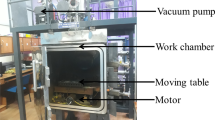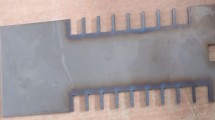Abstract
The process parameters involved in electron beam welding have major influences on spiking and penetration efficiency of the joint. In addition to this, the input–output relationships of electron beam welding are nonlinear and complex in nature. Therefore, adaptive neuro-fuzzy inference system (ANFIS)-based input–output modeling had been attempted to predict the spiking severity in electron beam welded joints. Swarm-based optimization algorithms, like grey wolf optimizer, particle swarm optimization, and bonobo optimizer (BO), were used for optimizing the ANFIS architecture and predicting the response precisely. Multi-objective bonobo optimization (MOBO), Multi-objective grey wolf optimization, and Multi-objective particle swarm optimization algorithms had been used for solving the conflicting multi-objective criteria problems associated with the study. The input process parameters were accelerating voltage, beam current, scan speed, focusing distance, and beam oscillation parameters, whereas mean weld-bead penetration and its standard deviation were considered as the responses of the system. The irregular penetration, that is, spiking was expressed in terms of the standard deviation of weld penetration. The accuracy level of optimization and modeling had been tested with some test cases obtained through the real experiments. MOBO had shown the better accuracy in predicting the optimized set of input parameters, which could satisfy both the spiking and penetration criteria, while BO-ANFIS had shown the superior efficiency in predicting the response with minimum error.





















Similar content being viewed by others
References
Alonso, V.; Dacal-Nieto, A.; Barreto, L.; Amaral, A.; Rivero, E.: Industry 4.0 implications in machine vision metrology: an overview. Procedia Manuf. 41, 359–66 (2019). https://doi.org/10.1016/j.promfg.2019.09.020
Sun, Z.; Karppi, R.: The application of electron beam welding for the joining of dissimilar metals: an overview. J. Mater. Process. Technol. 59, 257–267 (1996). https://doi.org/10.1016/0924-0136(95)02150-7
Jaypuria, S.; Doshi, N.; Pratihar, D.K.: Effects of welding parameters on mechanical properties in electron beam welded CuCrZr alloy plates effects of welding parameters on mechanical properties in electron beam welded CuCrZr alloy plates. Mater. Sci. Eng. 338, 012013 (2018). https://doi.org/10.1088/1757-899X/338/1/012013
Schultz, H.: Electron beam welding. Woodhead Publishing Ltd, Sawston (1994)
Jaypuria, S.; Gupta, S.K.; Pratihar, D.K.: Comparative study of feed-forward and recurrent neural networks in modeling of electron beam welding. In: Advances in Additive Manufacturing and Joining, pp. 521–531. Springer, Singapore (2020). https://doi.org/10.1007/978-981-32-9433-2_45
Jaypuria, S.; Chakrabarti, D.; Pratihar, D. K.: Effect of beam oscillations on formation of defects in electron beam welding of copper plate. ASME 2019 14th Int. Manuf. Sci. Eng. Conf. MSEC 2019, vol. 2, American Society of Mechanical Engineers (ASME); 2019. https://doi.org/10.1115/MSEC2019-2943.
Liu, C.; He, J.: Numerical analysis of fluid transport phenomena and spiking defect formation during vacuum electron beam welding of 2219 aluminium alloy plate. Vacuum 132, 70–81 (2016). https://doi.org/10.1016/j.vacuum.2016.07.033
Bardin, F.; Cobo, A.; Lopez-Higuera, J.M.; Collin, O.; Aubry, P.; Dubois, T., et al.: Optical techniques for real-time penetration monitoring for laser welding. Appl. Opt. 44, 3869–3876 (2005). https://doi.org/10.1364/AO.44.003869
Jaypuria, S.; Meher, J.; Kanigalpula, P.K.C.; Pratihar, D.K.: Electron beam butt welding of Cu-Cr-Zr alloy plates: experimental investigations, studies on metallurgical and mechanical properties. Fusion Eng. Des. 137, 209–220 (2018). https://doi.org/10.1016/j.fusengdes.2018.10.004
Luo, M.; Hu, R.; Liu, T.; Wu, B.; Pang, S.: Optimization possibility of beam scanning for electron beam welding: Physics understanding and parameters selection criteria. Int. J. Heat Mass Transf. 127, 1313–1326 (2018). https://doi.org/10.1016/j.ijheatmasstransfer.2018.07.014
Trushnikov, D.N.; Koleva, E.G.; Mladenov, G.M.; Belenkiy, V.Y.: Effect of beam deflection oscillations on the weld geometry. J. Mater. Process. Technol. 213, 1623–1634 (2013). https://doi.org/10.1016/j.jmatprotec.2013.03.028
Fetzer, F.; Hu, H.; Berger, P.; Weber, R.; Eberhard, P.; Graf, T.: Fundamental investigations on the spiking mechanism by means of laser beam welding of ice. J. Laser Appl. 30, 012009 (2018). https://doi.org/10.2351/1.4986641
Kanigalpula, P.K.C.; Jaypuria, S.; Pratihar, D.K.; Jha, M.N.: Experimental investigations, input-output modeling, and optimization of spiking phenomenon in electron beam welding of ETP copper plates. Meas. J. Int. Meas. Confed. 129, 302–318 (2018). https://doi.org/10.1016/j.measurement.2018.07.040
Zhang, M.; Chen, G.; Zhou, Y.; Liao, S.: Optimization of deep penetration laser welding of thick stainless steel with a 10kW fiber laser. Mater. Des. 53, 568–576 (2014). https://doi.org/10.1016/j.matdes.2013.06.066
Fu, P.; Mao, Z.; Zuo, C.; Wang, Y.; Wang, C.: Microstructures and fatigue properties of electron beam welds with beam oscillation for heavy section TC4-DT alloy. Chin. J. Aeronaut. 27, 1015–1021 (2014). https://doi.org/10.1016/j.cja.2014.03.020
Jaypuria, S.; Gupta, S.K.; Pratihar, D.K.; Chakrabarti, D.; Jha, M.N.: Effect of amplitude oscillation on spiking in electron beam welding of copper plate. In: Advances in Materials and Manufacturing Engineering, pp. 405–411. Springer, Singapore (2020)
Schweier, M.; Heins, J.F.; Haubold, M.W.; Zaeh, M.F.: Spatter formation in laser welding with beam oscillation. Phys. Procedia 41, 20–30 (2013). https://doi.org/10.1016/j.phpro.2013.03.047
Yan, W.; Zhang, H.; Jiang, Z.G.; Hon, K.K.B.: Multi-objective optimization of arc welding parameters: the trade-offs between energy and thermal efficiency. J. Clean. Prod. 140, 1842–1849 (2017). https://doi.org/10.1016/j.jclepro.2016.03.171
Yang, Y.; Cao, L.; Zhou, Q.; Wang, C.; Wu, Q.; Jiang, P.: Multi-objective process parameters optimization of Laser-magnetic hybrid welding combining Kriging and NSGA-II. Robot. Comput. Integr. Manuf. 49, 253–262 (2018). https://doi.org/10.1016/j.rcim.2017.07.003
Das, A.K.; Das, D.; Jaypuria, S.; Pratihar, D.K.; Roy, G.G.: Input-output modeling and multi-objective optimization of weld attributes in EBW. Arab. J. Sci. Eng. 46, 4087–4101 (2021). https://doi.org/10.1007/S13369-020-05248-1/TABLES/10
Wang, X.; Yan, Y.; Gu, X.: Spot welding robot path planning using intelligent algorithm. J Manuf Process 42, 1–10 (2019). https://doi.org/10.1016/j.jmapro.2019.04.014
Das, A.K.; Das, D.; Pratihar, D.K.: Multi-objective optimization and cluster-wise regression analysis to establish input-output relationships of a process. In: Multi-Objective Optimization, pp. 299–318. Springer, Singapore (2018). https://doi.org/10.1007/978-981-13-1471-1_14
Norouzi, A.; Hamedi, M.; Adineh, V.R.: Strength modeling and optimizing ultrasonic welded parts of ABS-PMMA using artificial intelligence methods. Int. J. Adv. Manuf. Technol. 61, 135–147 (2012). https://doi.org/10.1007/s00170-011-3699-2
Jaypuria, S.; Pratihar, D.K.: Fuzzy Inference System-Based Neuro-Fuzzy Modeling of Electron-Beam Welding, p. 839–50. Springer, Singapore (2019) https://doi.org/10.1007/978-981-32-9072-3_70
Babajanzade Roshan, S.; Behboodi Jooibari, M.; Teimouri, R.; Asgharzadeh-Ahmadi, G.; Falahati-Naghibi, M.; Sohrabpoor, H.: Optimization of friction stir welding process of AA7075 aluminum alloy to achieve desirable mechanical properties using ANFIS models and simulated annealing algorithm. Int. J. Adv. Manuf. Technol. 69, 1803–1818 (2013). https://doi.org/10.1007/s00170-013-5131-6
Vijayan, D.; Seshagiri, R.V.: Parametric optimization of friction stir welding process of age hardenable aluminum alloys−ANFIS modeling. J. Cent. South Univ. 23, 1847–1857 (2016). https://doi.org/10.1007/s11771-016-3239-1
Dhas, J.E.R.; Kumanan, S.: Modeling of residual stress in butt welding. Mater. Manuf. Process. 26, 942–947 (2011). https://doi.org/10.1080/10426914.2011.560232
Wu, D.; Chen, H.; Huang, Y.; He, Y.; Hu, M.; Chen, S.: Monitoring of weld joint penetration during variable polarity plasma arc welding based on the keyhole characteristics and PSO-ANFIS. J. Mater. Process. Technol. 239, 113–124 (2017). https://doi.org/10.1016/j.jmatprotec.2016.07.021
Jaypuria, S.; Mahapatra, T.R.; Jaypuria, O.: Metaheuristic tuned ANFIS model for input-output modeling of friction stir welding. Mater. Today Proc. 18, 3922–30 (2019). https://doi.org/10.1016/j.matpr.2019.07.332
Maroufpoor, S.; Maroufpoor, E.; Bozorg-Haddad, O.; Shiri, J.; Mundher, Y.Z.: Soil moisture simulation using hybrid artificial intelligent model: Hybridization of adaptive neuro fuzzy inference system with grey wolf optimizer algorithm. J. Hydrol. 575, 544–556 (2019). https://doi.org/10.1016/j.jhydrol.2019.05.045
Das, A.K.; Pratihar, D.K.: Optimal preventive maintenance interval for a Crankshaft balancing machine under reliability constraint using Bonobo Optimizer. In: IFToMM World Congress on Mechanism and Machine Science, pp. 1659–68. Springer, Cham (2019)
Jaypuria, S.; Das, A.K.; Pratihar, D.K.: Swarm-Intelligence-Based Computation for Parametric Optimization of Electron Beam Fabrication, p. 153–63. Springer, Singapore (2019) https://doi.org/10.1007/978-981-32-9072-3_14
Dewan, M.W.; Huggett, D.J.; Warren Liao, T.; Wahab, M.A.; Okeil, A.M.: Prediction of tensile strength of friction stir weld joints with adaptive neuro-fuzzy inference system (ANFIS) and neural network. Mater. Des. 92, 288–299 (2016). https://doi.org/10.1016/j.matdes.2015.12.005
Pratihar, D.K.: Soft computing: fundamentals and applications. Alpha Science International Ltd; 2015
Kennedy, J.; Eberhart, R.: Particle swarm optimization. Proc. ICNN’95 Int. Conf. Neural Netw. 4, 1942–8 (1995). https://doi.org/10.1109/ICNN.1995.488968
Shamshirband, S.; Hadipoor, M.; Baghban, A.; Mosavi, A.; Bukor, J.; Várkonyi-Kóczy, A.R.: Developing an ANFIS-PSO model to predict mercury emissions in combustion flue gases. Mathematics 7, 965 (2019). https://doi.org/10.3390/math7100965
Mirjalili, S.; Mirjalili, S.M.; Lewis, A.: Grey wolf optimizer. Adv. Eng. Softw. 69(46), 61 (2014). https://doi.org/10.1016/j.advengsoft.2013.12.007
Dehghani, M.; Seifi, A.; Riahi-Madvar, H.: Novel forecasting models for immediate-short-term to long-term influent flow prediction by combining ANFIS and grey wolf optimization. J. Hydrol. 576, 698–725 (2019). https://doi.org/10.1016/j.jhydrol.2019.06.065
Esmin, A.A.A.; Coelho, R.A.; Matwin, S.: A review on particle swarm optimization algorithm and its variants to clustering high-dimensional data. Artif. Intell. Rev. 44, 23–45 (2015). https://doi.org/10.1007/s10462-013-9400-4
Das, A. K.; Pratihar, D. K.: A New Bonobo optimizer (BO) for Real-Parameter optimization. Proc. 2019 IEEE Reg. 10 Symp. TENSYMP 2019, Institute of Electrical and Electronics Engineers Inc.; 2019, p. 108–13. https://doi.org/10.1109/TENSYMP46218.2019.8971108.
Coello, C.C.; Lechuga, M.S.: MOPSO A proposal for multiple objective particle swarm optimization. Proc. Congr. Evol. Comput. 2, 1051–1056 (2002). https://doi.org/10.1109/CEC.2002.1004388
Poli, R.; Kennedy, J.; Blackwell, T.: Particle swarm optimization: an overview. Swarm Intell. 1, 33–57 (2007). https://doi.org/10.1007/s11721-007-0002-0
Mirjalili, S.; Saremi, S.; Mirjalili, S.M.; Coelho, L.D.S.: Multi-objective grey wolf optimizer: a novel algorithm for multi-criterion optimization. Expert Syst. Appl. 47, 106–119 (2016). https://doi.org/10.1016/j.eswa.2015.10.039
Das, A.K.; Nikum, A.K.; Krishnan, S.V.; Pratihar, D.K.: Multi-objective Bonobo Optimizer (MOBO): an intelligent heuristic for multi-criteria optimization. Knowl. Inf. Syst. 62, 4407–4444 (2020). https://doi.org/10.1007/S10115-020-01503-X/TABLES/8
Deb, K.; Pratap, A.; Agarwal, S.; Meyarivan, T.: A fast and elitist multiobjective genetic algorithm: NSGA-II. IEEE Trans. Evol. Comput. 6, 182–197 (2002). https://doi.org/10.1109/4235.996017
Salehi, I.; Shirani, M.; Semnani, A.; Hassani, M.; Habibollahi, S.: Comparative study between response surface methodology and artificial neural network for adsorption of crystal violet on magnetic activated carbon. Arab. J. Sci. Eng. 41, 2611–2621 (2016). https://doi.org/10.1007/S13369-016-2109-3
Gupta, S.K.; Jaypuria, S.; Pratihar, D.K.; Saha, P.: Study on mechanical and metallurgical properties of fiber laser welded Nb-1% Zr-0.1% C alloy. Opt. Laser Technol. 127, 106153 (2020). https://doi.org/10.1016/j.optlastec.2020.106153
Acknowledgements
The authors like to thank Board Research Nuclear Science (BRNS), Department of Atomic Energy, Govt. of India, for providing the financial aid to procure and conduct experiments. We also convey our sincere regards to IIT Kharagpur, India, for providing the technical and administrative supports.
Author information
Authors and Affiliations
Corresponding author
Ethics declarations
Conflict of interest
Please note that there is no conflict of interest with anybody.
Rights and permissions
About this article
Cite this article
Jaypuria, S., Das, A.K., Kanigalpula, P.K.C. et al. Swarm Intelligence-based Modeling and Multi-objective Optimization of Welding Defect in Electron Beam Welding. Arab J Sci Eng 48, 1807–1827 (2023). https://doi.org/10.1007/s13369-022-07017-8
Received:
Accepted:
Published:
Issue Date:
DOI: https://doi.org/10.1007/s13369-022-07017-8




